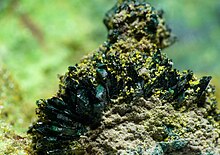Vandenbrandeite
| Vandenbrandeite | |
|---|---|
 | |
| General | |
| Category | Mineral |
| Formula (repeating unit) | Cu(UO2)(OH)4 |
| Strunz classification | 04.GB.45 |
| Dana classification | 05.03.02.01 |
| Crystal system | Triclinic |
| Crystal class | Triclinic-Pinacoidal |
| Space group | P1 |
| Unit cell | 254.99 ų |
| Identification | |
| Color | Blackish green to dark green with bluish green tint |
| Cleavage | Perfect on {001}, {110} Distinct and also indisctinct in the [001] zone |
| Fracture | None |
| Tenacity | Brittle |
| Mohs scale hardness | 4 |
| Luster | Vitreous, sub-vitreous, greasy |
| Streak | Green |
| Diaphaneity | Transparent, translucent |
| Specific gravity | 5.03 |
| Density | 5.03 |
| Optical properties | Biaxial (-) |
| Refractive index | nα = 1.765 - 1.770 nβ = 1.780 - 1.792 nγ = 1.800 |
| Birefringence | 0.035 |
| Pleochroism | Visible |
| 2V angle | Measured 90° Calculated 60°- 88° |
| Dispersion | None |
| Ultraviolet fluorescence | None |
| Other characteristics | |
Vandenbrandeite is a mineral named after a belgian geologist, Pierre Van den Brande, who discovered an ore deposit. It was named in 1932, and has been a valid mineral ever since then.[1]
Properties[]
Vandenbrandeite grows in microcrystals, up to half a millimeter. It may be rounded, lathlike. The crystals are flattened on {001} It grows in parallel aggregates, in a lamellar, scaly shape.[2] It is tabular, meaning its dimensions in one direction are weak.[3] It is a pleochroic mineral. Depending on the axis the mineral is seen the color of it changes, which is an optical phenomenon. On the x axis it can be seen as a blue-green, and on the z axis is seen as a yellow-green mineral. It is highly stable in the presence of both water and hydrogen peroxide.[1] It is a secondary mineral. Vandenbrandeite is a strongly radioactive mineral, which is due to the vandenbrandeite's composition. The mineral is made out of 59.27% uranium, which is the main component of the mineral. It has a GRapi () of 4,352,567.33. It has a concentration of 229.75 measured in GRapi. Other chemical elements included in vandenbrandeite are oxygen (23.9%), copper (15.82%) and hydrogen (1%). Although it is radioactive, the mineral is not fluorescent.[3]
References[]
- ^ a b "Vandenbrandeite". www.mindat.org. Retrieved 2021-09-24.
- ^ "Vandenbrandeite". National Gem Lab. 2017-03-27. Retrieved 2021-09-24.
- ^ a b "Vandenbrandeite Mineral Data". webmineral.com. Retrieved 2021-06-22.
- Uranium minerals
- Copper minerals
- Triclinic minerals